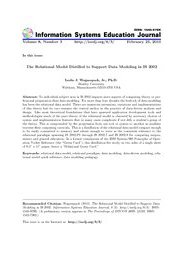Volume 8
Volume 8, Number 3 |
February 23, 2010 |

|
Leslie J. Waguespack, Jr., Ph.D.
|
Abstract: No individual subject area in IS 2002 impacts more aspects of computing theory or professional preparation than data modeling. For more than four decades the bedrock of data modeling has been the relational data model. There are numerous extensions, variations and implementations of this theory but its core remains the central anchor in the practice of data-driven analysis and design. Like most theoretical foundations that have spawned application development tools and methodologies much of the pure theory of the relational model is obscured by necessary choices of syntax and implementation features that in many cases complicate if not defy a student’s grasp of the theory. This is compounded by the progression from one tool or syntax to another as students traverse their computing curricula. This is a distillation of the relational data model compact enough to be easily committed to memory and robust enough to serve as the consistent reference to the relational paradigm spanning IS 2002.P0 through IS 2002.7 and IS 2002.8 for computing majors, minors and general education. In a format reminiscent of the IBM System/360 Principles of Operation Pocket Reference (the “Green Card”), this distillation fits nicely on two sides of a single sheet of 8.5” x 11” paper, hence a “Relational Green Card.”
Keywords: relational data model, relational paradigm, data modeling, data-driven modeling, relational model quick reference, data modeling pedagogy
Download this issue: ISEDJ.8(3).Waguespack.pdf (Adobe PDF, 10 pages, 1630 K bytes)
Preview the contents: Waguespack.j.txt (ASCII txt, 19 K bytes)
Recommended Citation: Waguespack (2010). The Relational Model Distilled to Support Data Modeling in IS 2002. Information Systems Education Journal, 8 (3). http://isedj.org/8/3/. ISSN: 1545-679X. (A preliminary version appears in The Proceedings of ISECON 2009: §3133. ISSN: 1542-7382.)